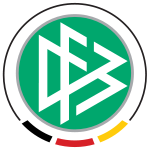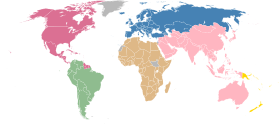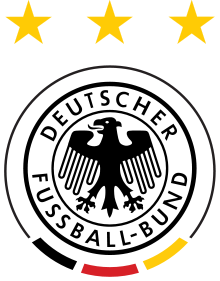- German Football Association
-
For other uses, see DFB (disambiguation).
German Football Association UEFA 
Founded January 28, 1900 FIFA affiliation 1904 UEFA affiliation 1954 President Theo Zwanziger The German Football Association (German: Deutscher Fußball-Bund; DFB) is the governing body of football in Germany. A founding member of both FIFA and UEFA, the DFB organises the German football leagues, including the national league, the Bundesliga, and the men's and women's national teams. The DFB is based in Frankfurt and is divided into five regional federations with 21 regional organizations. The German Football Association is the largest single sports federation in the world.
Contents
History
 Historical logo of the DFB ca. 1911, in National colours of Germany of the time
Historical logo of the DFB ca. 1911, in National colours of Germany of the time
From 1875 to the mid 1880s, the first kind of football played in Germany was according to rugby rules. Later, association-style football teams formed separate clubs, and since 1890, they began to organise on regional and national levels.
The DFB (Deutscher Fußball-Bund) was founded in 1900 in Leipzig by representatives of 86 clubs. The DFB consolidated the large number of state-based German regional competitions in play for a single recognized national title for the season 1902/03. Germans were not present in Paris when FIFA was founded by seven nations in May 1904, but by the time the FIFA statutes came into effect on 1 September, Germany had also joined by telegram as the eighth nation. The German national team played its first game in 1908.
Before 1914, the German Empire was much larger than today's Germany, comprising Alsace-Lorraine and the Eastern provinces. The borders of the regional associations were drawn according to suitable railway connections. Also, teams based in Bohemia, then part of Austria-Hungary, were eligible, as it was surrounded on three sides by the German Empire. Thus, a team of Prague was runner-up in the German championship. On the other hand, clubs of the Danish minority in Northern Schleswig refused to join the DFB. This area after World War I voted to join Denmark. Due to borders changes imposed by the Treaty of Versailles, the DFB had to adopt its structure. The Saarland, Danzig, and the Memelland were detached from Germany and East Prussia was cut off from the main part by the Polish Corridor.
The role of DFB and its representatives like Felix Linnemann during Nazi Germany was documented in 100 Jahre DFB and by Nils Havemann in Fußball unterm Hakenkreuz.[1] According to Gleichschaltung policy, the DFB, with its large membership from all political sides, and strong regional structures compared to weak national ones, submitted to new rulers and new Gau structures. On a short general meeting on 9 July 1933 in Berlin, the DFB did so, at least formally. Later, the Hitler salute was made compulsory; Marxists and Jews were expelled. A new organization, Deutscher Reichsbund für Leibesübungen (German Reich League for Physical Exercise), was established and Linnemann was appointed leader of its Fachamt Fußball (Football section), which took over the operational affairs, whereas the DFB lost most of its duties until it was formally dissolved in 1940.
On the pitch, Germany had done well in 1934, but after a 0–2 loss in the 1936 Summer Olympics, with Adolf Hitler attending, the DFB and football fell from grace. Reichsjugendführer Baldur von Schirach and Hitlerjugend took over youth football (under 16) from the clubs following a deal with Reichssportführer Hans von Tschammer und Osten, who had been in charge of all sports in Germany since 1933, making DFB officials even more powerless. Germany had made a bid to host the 1938 World Cup, but it was withdrawn without comment.
Following the Anschluss in March 1938 that made Austria part of Germany, the Austrian Football Association became part of the German federation. New coach Sepp Herberger was told on short notice to use also Austrian players in his team, which was eliminated in the first round of the World Cup, weakening the situation of football within Nazi politics to near meaninglessness. Four Germans (Hans Jakob, Albin Kitzinger, Ludwig Goldbrunner, and Ernst Lehner) represented West Europe in a FIFA friendly on 20 June 1937 in Amsterdam, and another two (Kitzinger again and Anderl Kupfer) represented a FIFA continental team on 26 October 1938 in London, England.
During the war, Germany played international games until 1942. In the aftermath of World War II, German organisations were disbanded by the allies. The FIFA decided in November 1945 to ban the no longer existing DFB (and Japan) from international competition. Internationally, Germans were still represented, with Zürich-based Ivo Schricker serving as General Secretary of FIFA from 1932 to December 1950. In 1948, Switzerland requested FIFA to lift the ban on games against Germans, but this was denied. Swiss clubs played German clubs anyway, but had to cease doing so due to international protests. This was only changed in 1949 when The Football Association requested FIFA to lift the ban on club games. FIFA did so on 7 May 1949, two weeks before the Federal Republic of Germany was founded, thus games required permission by the military governments of the time.
Due to partition into several occupation zones, and states, the DFB was legally re-founded in Stuttgart on 21 January 1950 only by the West German regional associations, without the Saarland Football Association in the French occupied Saarland, which on 12 June 1950 would be recognized by FIFA as the first of three German FAs after the war. At the FIFA congress held on 22 June prior to the 1950 FIFA World Cup in Brazil, the Swiss Football Association requested that DFB is reinstated with full FIFA membership, which was granted on 22 September 1950[2] in Bruxelles. Germany resumed international games in late 1950. The teams of the DFB and the Saarland were squared off in the Qualifiers for the 1954 WC before the Saarland and its FA was permitted to rejoin Germany and the DFB in 1956.
In the early years of the division of Germany, West Germany claimed exclusive mandate of all of Germany. Unlike the IOC, which granted only provisional recognition to the East Germans in 1955, demanding they participate in an All-German Olympic team (Unified Team of Germany), the FIFA fully recognized the East German Football Association in 1952. Winning the 1954 World Cup was a major success for the DFB, and the popularity of the sport in Germany.
Due to that success, and due to regional associations fearing to lose influence, the old amateur structure, in which five regional leagues represented the top level, remained in effect longer than in many other countries, even though a Reichsliga had been proposed decades ago. Also, professionalism was rejected, and players who played abroad were considered "mercenaries" and not capped. The conservative attitude changed only after disappointing results in the 1962 WC when officials like the 75 year old Peco Bauwens retired. According to the proposals of Hermann Neuberger, the DFB finally introduced a single nation-wide professional league, the Fußball-Bundesliga, for the 1963–64 season.
In 1974, the DFB hosted (and won) the World Cup. Germany also hosted the 1988 European Championship. Upon reunification in 1990, the Deutscher Fußball Verband der DDR (DFV) was absorbed into the DFB. For 2006, Germany and the DFB once again hosted a World Championship tournament.
Other
Today, about 26,000 clubs are members, fielding 170,000 teams with over two million active players and totalling over six million members, the largest membership of any single sports federation in the world. The DFB also has 870,000 female members and 8,600 female teams. The DFB is also the richest single sports federation worldwide.
The official mascot is an eagle with black feathers and yellow beak called "Paule" (since 26 March 2006).
Presidents
- Ferdinand Hueppe (1900–1904)
- Friedrich Wilhelm Nohe (1904–1905)
- Gottfried Hinze (1905–1925)
- Felix Linnemann (1925–1945)
- Peco Bauwens (1949–1962)
- Hermann Gösmann (1962–1975)
- Hermann Neuberger (1975–1992)
- Egidius Braun (1992–2001)
- Gerhard Mayer-Vorfelder (2001–2004)
- Gerhard Mayer-Vorfelder and Theo Zwanziger (2004–2006)
- Theo Zwanziger (2006–)
Regional associations
The DFB in turn is sub-divided into five regional associations, which, again, are also divided into sub-associations in total of twenty-one. These associations, in most cases, have their boundaries run along the same lines as the federal German states.
Southern Germany
The Southern German Football Association (German: Süddeutscher Fußball-Verband – SFV) covers the three Southern German states of Bavaria, Hesse and Baden-Württemberg.[3] The SFV, formed on 17 October 1897 under the name of Verband Süddeutscher Fußball-Vereine, originally administered the Southern German football championship, until it was dissolved by the Nazis in 1933. Reformed after the Second World War, it operated the Oberliga Süd as its highest league until 1963. In the 2008–09 season, the SFV is in charge of the Regionalliga Süd (IV) for men and women. The league above, the 3rd Liga, is administered by the DFB, while the leagues below are administered by the SFV's five regional associations.[4]
- Baden Football Association (Badischer Fußball-Verband – BFV)
- Bavarian Football Association (Bayerischer Fußball-Verband – BFV)
- Hessian Football Association (Hessischer Fußball-Verband – HFV)
- South Baden Football Association (Südbadischer Fußball-Verband – SBFV)
- Württemberg Football Association (Württembergischer Fußball-Verband – WFV)
South Western Germany
The Southwestern German Football Association (German: Fußball-Regional-Verband Südwest – FRVS) was formed after the Second World War in the French occupation zone in Germany. Its highest league until 1963 was the Oberliga Südwest. It is subdivided into three regional associations covering two states, Rhineland-Palatinate and Saarland with the current highest league in the region, the tier-five Oberliga Südwest, administered by the FRVS:[5]
- Rhineland Football Association (Fußball-Verband Rheinland – FVR)
- Saarland Football Association (Saarländischer Fußball-Verband – SFV)
- Southwest Football Association (Südwestdeutscher Fußball-Verband -SWFV)
Western Germany
The Western German Football and Athletics Association (German: Westdeutscher Fußball- und Leichtathletik Verband – WFV) covers the state of North Rhine-Westphalia and is sub-divided into three football associations. The association used to administer the Western German football championship until 1933. From 1947 to 1963, its highest league was the Oberliga West and, since 2008, the Nordrhein-Westfalen Liga is administered by it. Its three sub-associations are:[6]
- Middle Rhine Football Association (Fußballverband Mittelrhein – FVM)
- Lower Rhine Football Association (Fußballverband Niederrhein – FVN)
- Westphalia Football and Athletics Association (Fußball- und Leichtathletikverband Westfalen – FLVW)
Northern Germany
The Northern German Football Association (German: Norddeutscher Fußball-Verband – NFV) covers the states of Bremen, Hamburg, Lower Saxony and Schleswig-Holstein and is sub-divided into four football associations. The association used to administer the Northern German football championship until 1933. From 1947 to 1963, its highest league was the Oberliga Nord, which, intermidently, existed again from 1974 to 2008. Its four sub-associations are:[7]
- Bremen Football Association (Bremer Fußball-Verband – BFV)
- Hamburg Football Association (Hamburger Fußball-Verband – HFV)
- Lower Saxony Football Association (Niedersächsischer Fußball-Verband – NFV)
- Schleswig-Holstein Football Association Schleswig-Holsteinischer Fußball-Verband – SHFV)
North Eastern Germany
The North Eastern German Football Association (German: Nordostdeutscher Fußball-Verband – NOFV) is the youngest of the five regional associations, having been formed after the German reunion in 1990. It administrates the two tier-five NOFV-Oberligas, North and South.[8] It covers the federal states of Brandenburg, Berlin, Mecklenburg-Vorpommern, Saxony, Saxony-Anhalt and Thuringia. Each of these six states has their own football association:
- Brandenburg Football Association (Fußballlandes-Verband Brandenburg – FLB)
- Berlin Football Association (Berliner Fußball-Verband – BFV)
- Mecklenburg-Vorpommern Football Association (Landesfußball-Verband Mecklenburg-Vorpommern – LFVM)
- Saxony Football Association (Sächsischer Fußball-Verband – SFV)
- Saxony-Anhalt Football Association (Fußball-Verband Sachsen-Anhalt – FSA)
- Thuringia Football Association (Thüringer Fußball-Verband – TFV)
See also
- German football league system
- History of German football
- Nationalsozialistischer Reichsbund für Leibesübungen
References
- ^ Nils Havemann Fußball unterm Hakenkreuz. Der DFB zwischen Sport, Politik und Kommerz Bonn: Bundeszentrale für politische Bildung, 2006
- ^ DFB – Deutscher Fußball-Bund e.V. – Die DFB-Geschichte
- ^ Southern German Football Association website (German) accessed: 18 May 2009
- ^ 100 Jahre Süddeutscher Fußball-Verband (German) 100 Year anniversary book of the SFV, published: 1997, accessed: 18 May 2009
- ^ Southwestern German Football Association website (German) accessed: 19 May 2009
- ^ Western German Football Association website (German) accessed: 18 May 2009
- ^ Northern German Football Association website (German) accessed: 18 May 2009
- ^ North Eastern German Football Association website (German) accessed: 18 May 2009
External links
- (German)/(English) Official website
- Germany at FIFA site
- Germany at UEFA site
Football in Germany German Football AssociationLeague competitions Cup competitions National teams National team · B team · Olympic team · U21 team · Other youth teams · Manager · World Cup performanceFIFA World Cup · Host nations 1954:
 Switzerland
Switzerland
1958: Sweden
Sweden
1962: Chile
Chile
1966: England
England
1970: Mexico
Mexico
1974: West Germany
West GermanyWomen's football in Germany League competitions Cup competitions National teams Lists German Football AssociationInternational association football FIFA · World Cup · Confederations Cup · U-20 World Cup · U-17 World Cup · Olympics · Minor tournaments · World Rankings · Player of the Year · FIFA Ballon d'Or · Teams · Debuts · Competitions · Federations · CodesAsia 
Africa North,
Central America
and CaribbeanSouth America Oceania Europe Non-FIFA Games All-Africa Games · Asian Games · CARIFTA Games · East Asian Games · Francophonie Games · IOIG · Lusophony Games · Mediterranean Games · Pan American Games · Pan Arab Games · Pacific Games · South Asian Games · Southeast Asian GamesSee also International women's football.National football associations of Europe (UEFA) Albania · Andorra · Armenia · Austria · Azerbaijan · Belarus · Belgium · Bosnia and Herzegovina · Bulgaria · Croatia · Cyprus · Czech Republic · Denmark · England · Estonia · Faroe Islands · Finland · France · Georgia · Germany · Greece · Hungary · Iceland · Ireland · Israel · Italy · Kazakhstan · Latvia · Liechtenstein · Lithuania · Luxembourg · Macedonia · Malta · Moldova · Montenegro · Netherlands · Northern Ireland · Norway · Poland · Portugal · Romania · Russia · San Marino · Scotland · Serbia · Slovakia · Slovenia · Spain · Sweden · Switzerland · Turkey · Ukraine · Wales
defunct: East Germany · Saarland · Soviet Union · YugoslaviaState associations of the German FA State associations NorthBremen · Hamburg · Lower Saxony · Schleswig-HolsteinNorth-EastBrandenburg · Berlin · Mecklenburg-Vorpommern · Saxony · Saxony-Anhalt · ThuringiaWestLower Rhine · Middle Rhine · WestphaliaSouth-WestRhineland · Saarland · South WestSouthBaden · Bavaria · Hesse · South Baden · WürttembergCategory: German Football AssociationCategories:- UEFA member associations
- Football in Germany
- Sports governing bodies in Germany
- 1900 establishments in Germany
- German Football Association
Wikimedia Foundation. 2010.

